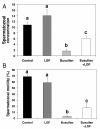Effect of liver growth factor on both testicular regeneration and recovery of spermatogenesis in busulfan-treated mice
- PMID: 21294894
- PMCID: PMC3042004
- DOI: 10.1186/1477-7827-9-21
Effect of liver growth factor on both testicular regeneration and recovery of spermatogenesis in busulfan-treated mice
Abstract
Background: Some adult stem cells persist in adult tissue; however, we do not know how to stimulate stem cells in adults to heal injuries. Liver growth factor (LGF) is a biliprotein with hepatic mitogen activity. Its concentration increases markedly in the presence of any type of liver injury, and it shows in vivo therapeutic biological activity at extrahepatic sites.
Methods: We have analyzed the effect of LGF on the replenishment of germinal cells in the testes of mice injected with busulfan, a common cancer drug that also specifically affects germ line stem cells and spermatogonia. We determined the testicular and epididymal weight, spermatozoal concentration in the epididymis and sperm motility, and performed a histological analysis.
Results: Intraperitoneal administration of LGF was able to partially restore spermatogenesis, as well as sperm production and motility, in mice sterilized with busulfan. LGF treatment in busulfan-treated animals that have suffered a disruption of spermatogenesis can accelerate the reactivation of this process in most of the tubules, as shown in the histological analysis.
Conclusions: Our results suggest a potential use of LGF in the mobilization of testicular stem cells and in the restoration of spermatogenesis after busulfan-induced damage to the testicular germinal epithelium.
Figures




Similar articles
-
Liver growth factor induces testicular regeneration in EDS-treated rats and increases protein levels of class B scavenger receptors.Am J Physiol Endocrinol Metab. 2015 Jan 15;308(2):E111-21. doi: 10.1152/ajpendo.00329.2014. Epub 2014 Nov 11. Am J Physiol Endocrinol Metab. 2015. PMID: 25389365
-
Involvement of ICAM-1 in impaired spermatogenesis after busulfan treatment in mice.Andrologia. 2016 Feb;48(1):37-44. doi: 10.1111/and.12414. Epub 2015 Mar 25. Andrologia. 2016. PMID: 25808259
-
Regenerative Potential of Stem and Progenitor Cells from Ischemic Testes of C57Bl/6 Mice in Culture and in the Model of Spermatogenesis Suppression Caused by Busulfan.Bull Exp Biol Med. 2017 Jan;162(3):400-405. doi: 10.1007/s10517-017-3625-1. Epub 2017 Jan 14. Bull Exp Biol Med. 2017. PMID: 28091913
-
[Recovery of the spermatogenic layer].Arkh Anat Gistol Embriol. 1988 May;94(5):76-83. Arkh Anat Gistol Embriol. 1988. PMID: 2901256 Review. Russian. No abstract available.
-
Spermatogenesis by Sisyphus: proliferating stem germ cells fail to repopulate the testis after 'irreversible' injury.Adv Exp Med Biol. 2001;500:421-8. doi: 10.1007/978-1-4615-0667-6_64. Adv Exp Med Biol. 2001. PMID: 11764975 Review.
Cited by
-
Effect of N-acetyl-L-cysteine on Testicular Tissue in Busulfan-Induced Dysfunction in the Male Reproductive System.World J Mens Health. 2023 Oct;41(4):882-891. doi: 10.5534/wjmh.220100. Epub 2023 Jan 1. World J Mens Health. 2023. PMID: 37118950 Free PMC article.
-
Histological Study on the Protective Effect of Endogenous Stem Cell Mobilization in Busulfan-Induced Testicular Injury in Albino Rats.J Microsc Ultrastruct. 2018 Oct-Dec;6(4):197-204. doi: 10.4103/JMAU.JMAU_35_18. J Microsc Ultrastruct. 2018. PMID: 30464893 Free PMC article.
-
NAD+ precursors promote the restoration of spermatogenesis in busulfan-treated mice through inhibiting Sirt2-regulated ferroptosis.Theranostics. 2024 Apr 15;14(6):2622-2636. doi: 10.7150/thno.92416. eCollection 2024. Theranostics. 2024. PMID: 38646657 Free PMC article.
-
Neuroprotective activity of peripherally administered liver growth factor in a rat model of Parkinson's disease.PLoS One. 2013 Jul 4;8(7):e67771. doi: 10.1371/journal.pone.0067771. Print 2013. PLoS One. 2013. PMID: 23861803 Free PMC article.
-
Neuroprotective role of liver growth factor "LGF" in an experimental model of cerebellar ataxia.Int J Mol Sci. 2014 Oct 21;15(10):19056-73. doi: 10.3390/ijms151019056. Int J Mol Sci. 2014. PMID: 25338046 Free PMC article.
References
-
- Diaz-Gil JJ, Munoz J, Albillos A, Rua C, Machin C, Garcia-Canero R, Cereceda RM, Guijarro MC, Trilla C, Escartin P. Improvement in liver fibrosis, functionality and hemodynamics in CCI4-cirrhotic rats after injection of the Liver Growth Factor. J Hepatol. 1999;30(6):1065–1072. doi: 10.1016/S0168-8278(99)80261-X. - DOI - PubMed
-
- Gonzalo-Gobernado R, Reimers D, Herranz AS, Diaz-Gil JJ, Osuna C, Asensio MJ, Baena S, Rodriguez-Serrano M, Bazan E. Mobilization of neural stem cells and generation of new neurons in 6-OHDA-lesioned rats by intracerebroventricular infusion of liver growth factor. J Histochem Cytochem. 2009;57(5):491–502. doi: 10.1369/jhc.2009.952275. - DOI - PMC - PubMed
-
- Reimers D, Herranz AS, Diaz-Gil JJ, Lobo MV, Paino CL, Alonso R, Asensio MJ, Gonzalo-Gobernado R, Bazan E. Intrastriatal infusion of liver growth factor stimulates dopamine terminal sprouting and partially restores motor function in 6-hydroxydopamine-lesioned rats. J Histochem Cytochem. 2006;54(4):457–465. doi: 10.1369/jhc.5A6805.2005. - DOI - PubMed
-
- Somoza B, Abderrahim F, Gonzalez JM, Conde MV, Arribas SM, Starcher B, Regadera J, Fernandez-Alfonso MS, Diaz-Gil JJ, Gonzalez MC. Short-term treatment of spontaneously hypertensive rats with liver growth factor reduces carotid artery fibrosis, improves vascular function, and lowers blood pressure. Cardiovasc Res. 2006;69(3):764–771. doi: 10.1016/j.cardiores.2005.08.021. - DOI - PubMed
Publication types
MeSH terms
Substances
LinkOut - more resources
Full Text Sources

